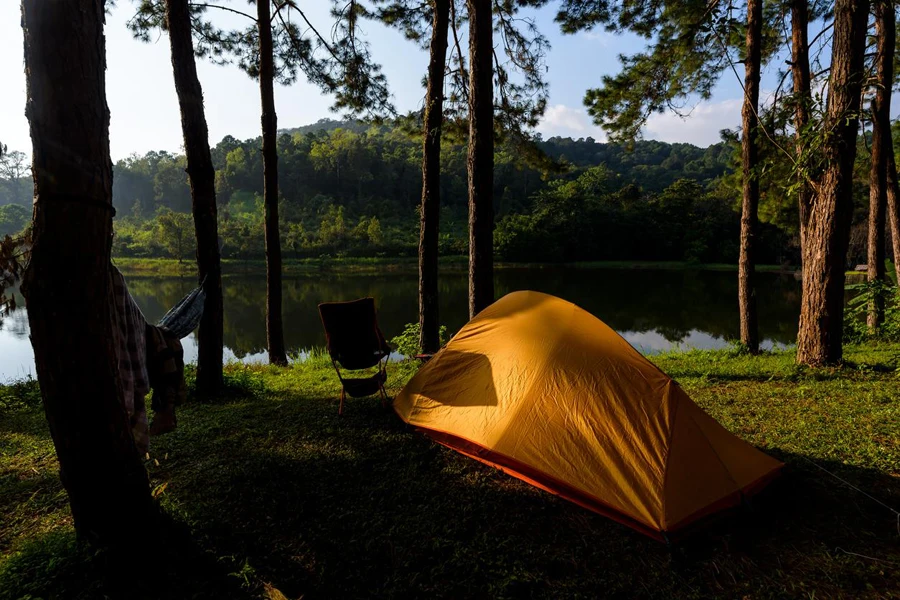In 2024, the camping tent market is undergoing a transformative shift, driven by evolving consumer preferences and technological advancements. These changes are significantly impacting the choices available for retailers and professionals procuring camping gear. The focus is on tents that not only meet diverse outdoor demands but also offer enhanced user experiences. This shift underscores the need for a strategic approach in selecting tents that cater to specific needs while delivering quality, reliability, and innovation, ensuring retailers can effectively meet the dynamic demands of modern outdoor enthusiasts.
Table of Contents:
1. The global camping tent market in 2024
2. Key considerations for selecting top-notch camping tents
3. Leading camping tent models and features of 2024
1. The global camping tent market in 2024
The global camping tent market in 2024 is experiencing substantial growth, driven by several key factors. According to Expert Market Research, the market size reached a value of USD 3.04 billion in 2023 and is expected to grow at a CAGR of 7% between 2024 and 2032, reaching USD 5.60 billion by 2032. Allied Market Research projects the market to reach $7.9 billion by 2031, growing at a CAGR of 8.8% from 2022 to 2031. IMARC Group’s analysis reveals a market size of USD 2.8 Billion in 2022, with a projection to reach USD 4.1 Billion by 2028, exhibiting a CAGR of 6.6% during 2023-2028.

In terms of regional analysis, Europe exhibits a clear dominance, accounting for the largest market share, driven by a cultural inclination towards outdoor activities and camping. North America also shows significant growth, influenced by an increasing trend towards outdoor and recreational activities. Asia Pacific is emerging as a promising market, with an increase in adventure tourism and the adoption of Westernized culture contributing to market growth.
The distribution channels for camping tents include specialty sporting goods stores, supermarkets and hypermarkets, and online stores. Specialty sporting goods stores account for the majority of the market share, attributed to their range of high-quality, specialized camping gear and expert advice.
2. Key considerations for selecting top-notch camping tents
When selecting top-notch camping tents for a diverse clientele in 2024, it’s crucial to consider various key factors that align with the evolving market demands.

Understanding different camping styles and needs
Different camping styles—from backpacking to car camping and glamping—dictate the type of tents that would best suit your customers. For backpackers, the focus is on lightweight, compact tents that are easy to carry. Car campers, in contrast, might prioritize larger, more comfortable tents with extra space for amenities. Glamping enthusiasts seek luxury in their outdoor experience, favoring tents with features that enhance comfort and convenience. Recognizing these diverse needs will enable you to cater effectively to a broad range of camping enthusiasts.

Evaluating tent durability and material quality
Durability is paramount in camping tents. High-quality materials like nylon and polyester offer resistance to weather elements and longevity. Some tents also integrate specialized fabrics for UV protection and enhanced ventilation. Advancements in materials contribute to the tent’s durability, impacting consumer choice significantly. The construction quality, including the seams, zippers, and poles, also plays a vital role in determining the tent’s resilience and usability in various outdoor conditions.
Importance of seasonality and weather adaptability
Camping tents are often categorized by their seasonality. Three-season tents, ideal for spring, summer, and fall, offer a balance of ventilation and protection from rain. Four-season tents, designed for harsher winter conditions, provide enhanced insulation and sturdiness against snow and strong winds. Some tents are equipped with features for specific weather conditions like extended rain flies for wet climates or ventilated roofs for hot environments. Understanding these aspects will help in selecting tents that align with the geographical and seasonal preferences of your customers.
3. Leading camping tent models and features of 2024
Review of popular tent models and their unique features
In 2024, the camping tent market is showcasing several standout models. For instance, tunnel tents, known for their spaciousness and ease of set-up, are dominating the market, particularly for family camping or extended expeditions. These tents are evolving with innovations like inflatable beams, replacing traditional poles for even easier setup. Dome and geodesic tents, while forming a smaller market segment, are praised for their lightweight design and ease of assembly, making them ideal for short trips and trekking.

Innovative design elements and user comfort
Modern tents are incorporating advanced materials to make them lighter yet more durable. Features like extended rainflies for wet climates and ventilated roofs for hot environments are becoming standard. Comfort-enhancing elements such as internal storage pockets, gear lofts, and larger vestibules are also increasingly common. These design elements cater to the growing demand for tents that offer a blend of comfort, convenience, and functionality.
Comparing price and performance for retail success
Price and performance remain critical factors in tent selection for retailers. The market offers a range of options, from budget-friendly models to high-end tents with advanced features. It’s important for retailers to balance costs with customer expectations and needs. High-quality materials, durability, and special features often justify a higher price point, appealing to a segment of consumers looking for premium camping experiences.

Highlighted models of camping tents in 2024
In 2024, the camping tent market boasts a variety of models, each tailored to specific camping needs and preferences. Here’s a detailed look at some of the leading tents and their unique features:
Coleman Skydome 2-Person Camping Tent
Key Features: This tent is celebrated for its spacious interior and affordability. It stands out for its tall ceiling, which is the highest among 2-person tents tested, providing a roomy fit for two people. The heavy-duty bathtub floor is especially effective at keeping puddles at bay.
Pros: Affordable, spacious for two people, and a high ceiling.
Cons: The small vestibule door and less straightforward fly setup.
MSR Habiscape 4-Person Tent
Key Features: The MSR Habiscape, also available in a 6-person model, boasts a high ceiling height extending around the tent, offering ample space. Its design focuses on handling inclement weather.
Pros: Great stuff sack, high ceiling height, and pockets accessible from outside the tent.
Cons: Smaller vestibule compared to other 4-person tents.
Additional Insights: The tent’s structural integrity is commendable, with additional poles that enhance stability without complicating the setup.
Eureka Copper Canyon LX8 8-Person Tent
Key Features: This tent is ideal for larger groups, featuring a 13-foot x 10-foot dimension, a 7-foot height, and weighing 33.5 pounds. It’s designed to withstand both rain and wind.
Pros: Great livable space, good weather resistance, multiple doors and windows.
Cons: More complicated setup and heavier weight.
Sea To Summit Alto TR1 Plus
Key Features: Summer backpacking.
Pros: It’s very lightweight and compact, offers ample headroom, and is made of breathable fabric. There’s also a 2-person version available.
Cons: The waterproof ratings could be better, which is a consideration for wetter climates.
Wild Country Zephyros Compact 2
Key Features: 3-season wild camping.
Pros: Lightweight, good waterproof ratings, and easy to pitch.
Cons: The space is very snug for 2 people and has a small porch area.
TentBox Classic
Key Features: Rooftop tent.
Pros: Quick to set up, features a hardy and aerodynamic hardshell, and several clever design touches.
Cons: No skylights, which might affect ventilation and light.
Conclusion
The camping tent market in 2024 is marked by diversity in product offerings, catering to various camping styles and preferences. From tunnel tents for family outings to lightweight dome tents for solo adventures, the market is ripe with options. Innovations in design and materials are enhancing user comfort and functionality, while pricing strategies are crucial for retail success. For retailers, understanding these market dynamics and aligning product selections with consumer needs is key to thriving in the camping tent industry.




